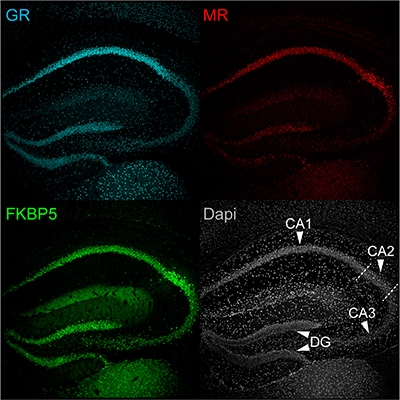By Jakob Hartmann and Kerry Ressler
Stress-related psychiatric conditions, including major depressive disorder (MDD) and posttraumatic stress disorder (PTSD), represent a significant global disease and social burden. Yet the underlying molecular mechanisms are still poorly understood. In addition to the autonomic nervous system, the primary control module of the stress response in mammals is the hypothalamic-pituitary-adrenal (HPA) axis, which regulates the circadian and stress-induced release of glucocorticoids (cortisol in humans, corticosterone in mice). Coordinated secretion of glucocorticoids in response to acute stress is beneficial. However, a dysregulated stress response of the body as a result of chronic stress or traumatic experiences can be damaging for the brain and promote susceptibility to mood and anxiety disorders.
Glucocorticoids orchestrate the activity of the HPA axis and neuronal circuits via the glucocorticoid receptor (GR, encoded by the Nr3c1 gene) and the mineralocorticoid receptor (MR, encoded by the Nr3c2 gene). An imbalance between central MR and GR signaling might underlie HPA axis dysregulation associated with the susceptibility to psychopathology such as MDD and PTSD. A key brain region involved in the regulation of the stress response is the hippocampus.

Immunofluorescence imaging of three key stress proteins in the mouse hippocampus: GR (cyan), MR (red) and FKBP5 (green), as well as DAPI (gray, labeling cell nuclei). When taking a closer look at this imaging across subregions of the hippocampus (CA1, CA2, CA3 and DG), we find that the GR is most prevalent in CA1, whereas FKBP5 is most prominently overlapping with the MR in CA2.
In this study, we dissected how three key stress proteins —the glucocorticoid receptor (GR), the mineralocorticoid receptor (MR), and the FK506-binding protein 51 (FKBP5)—interact with each other in the hippocampus to regulate the body’s response to stress.
Our experiments in neuronal cell culture, mice and postmortem brain tissue revealed that MRs, rather than GRs, control the expression of FKBP5 under normal conditions. FKBP5, in turn, decreases GRs’ sensitivity to binding stress hormones (glucocorticoids) during stressful situations. The results suggest that FKBP5 acts as a key modulator of HPA axis activity by mediating the fine-tuning of hippocampal MR:GR balance.
Our findings suggest that therapeutic targeting of GR, MR, and FKBP5 may be complementary in manipulating central and peripheral regulation of stress. Moreover, our data further underline the important but largely unappreciated role of MR signaling in stress-related psychiatric disorders. Current therapeutic options for stress-related psychiatric disorders, including MDD and PTSD, leave a high unmet need due to the lack of efficacy in many patients, slow response rates and substantial side effects. The development of novel treatments that more directly address the neurobiological alterations underlying these disorders is therefore essential. Specific modulation of GR, MR and/or FKBP5 activity may have the potential to correct the neuroendocrine disturbances observed in a subset of patients with depression and anxiety.
Jakob Hartmann is an assistant neuroscientist in the Neurobiology of Fear Laboratory at McLean Hospital and an instructor in psychiatry at Harvard Medical School.
Kerry Ressler is the chief scientific officer at McLean Hospital, chief of McLean’s Division of Depression and Anxiety Disorders, and a professor in psychiatry at Harvard Medical School.
Learn more in the original research article:
Mineralocorticoid receptors dampen glucocorticoid receptor sensitivity to stress via regulation of FKBP5
Hartmann J, Bajaj T, Klengel C, Chatzinakos C, Ebert T, Dedic N, McCullough KM, Lardenoije R, Joëls M, Meijer OC, McCann KE, Dudek SM, Sarabdjitsingh RA, Daskalakis NP, Klengel T, Gassen NC, Schmidt MV, Ressler KJ. Cell Rep. 2021 Jun 1;35(9):109185. doi: 10.1016/j.celrep.2021.109185. PMID: 34077736; PMCID: PMC8244946.
News Types: Community Stories
